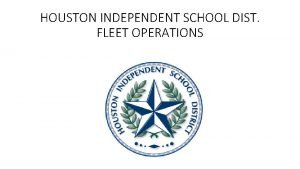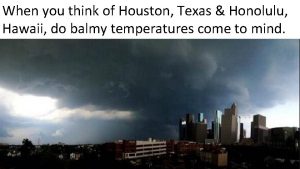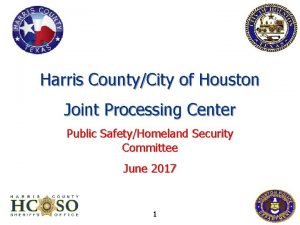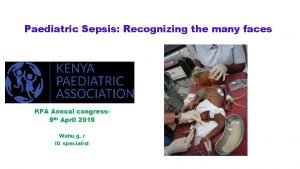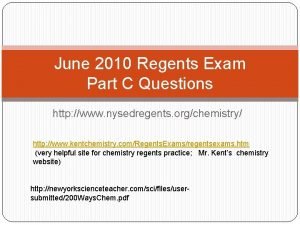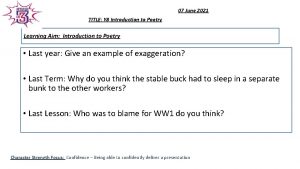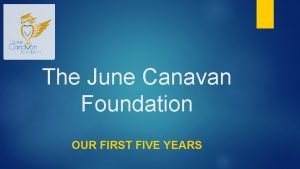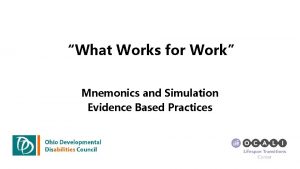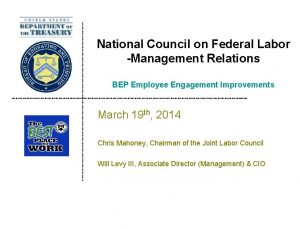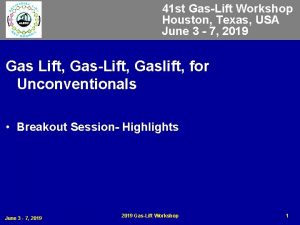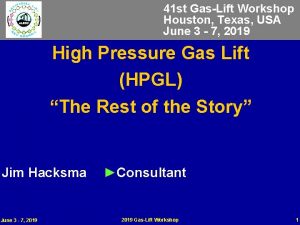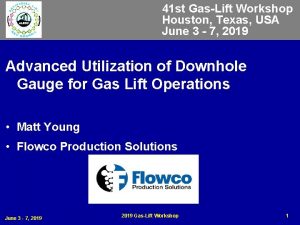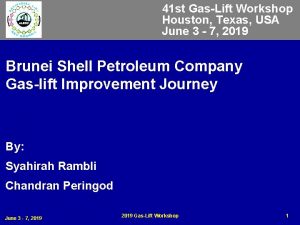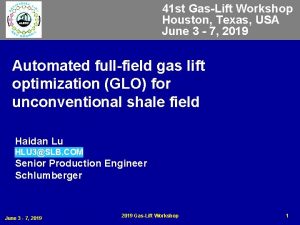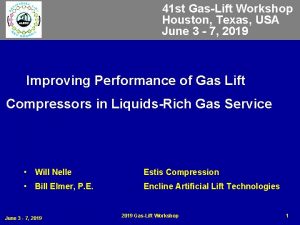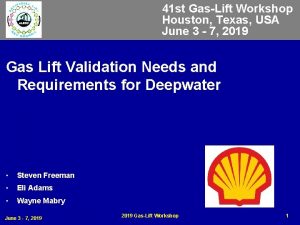41 st GasLift Workshop Houston Texas USA June









- Slides: 9

41 st Gas-Lift Workshop Houston, Texas, USA June 3 - 7, 2019 Gas Lift Validation Needs and Requirements for Deepwater • Steven Freeman • Eli Adams • Wayne Mabry June 3 - 7, 2019 Gas-Lift Workshop 1

Where is the need? Project only economical with Gas Lift • Location 150 miles southeast of New Orleans • Subsea well head 4, 000 Ft water • Desired analogue – BHP @ 23 Ksi – BHT @ 350˚F – PKR- KB/MD @ 26 K FT – 5. 5” tubing & 4. 5” – 30 year well life – 8 -10 MMUSD to pull GLV June 3 - 7, 2019 Gas-Lift Workshop 2

Gas Lift Capabilities in 2012 Back Checks rated to TR 2385 requirements & API • Design for 10 Ksi back check at max rated design temperature • 1 back check unit tested for validation – 20 cc leak rate over 10 minute hold minimum – Ambient back pressure validation testing & at max temp – Max pressure validation testing & at max temp – Liquid flow testing – Gas Flow rate testing – Testing is in sequence as stated in TR 2385 • Validation testing often not witnessed by Statoil staff • Validation of TR 2385 is accepted by Shell for Dry Tree projects June 3 - 7, 2019 Gas-Lift Workshop 3

Deepwater Gas Lift Validation Requirements • Control document that establishes the requirements for Shell’s subsea gas lift kit: – Side Pocket Mandrel-SPM – Flow Control Devices, Non-Metallics & Latches – Intervention tools • The requirements in this document may exceed the current requirements in the API 19 G series documents. In case of any deviation between this document and the API 19 G series documents, this document shall supersede the requirements for vendors to use. • Work along side suppliers providing expertise when necessary • Witness 100% of development, testing & manufacturing • Require API 19 G 1, 2, 3 & Q 1 qualification from supplier June 3 - 7, 2019 Gas-Lift Workshop 4

Why Create a Deepwater Gas Lift Control Document • Project Cost – Est. to drill & complete subsea well 75 -100 MM USD – Est. cost to pull subsea tubing 20 MM USD – Recomplete upper completion 25 MM USD • Dependence on gas lift to be economical – Subsea well cost makes ALS desirable from day 1 • Intervention cost for ALS systems in Subsea – Increased reliability & run life is the need – Decreased intervention frequency adds value June 3 - 7, 2019 Gas-Lift Workshop 5

Deepwater Gas Lift Control Document’s Achievement • Design Validation Process • Prototype Phase Requirements • Establishes Design methodology • • General design requirements • Project specific data provided Locks design & provides required validation testing necessary to satisfy project requirements. – FCDs- successful testing of 3 units with out fail or redress • Differential test at ambient & well conditions • Dictates involvement of end user’s experts with supplier • Long duration flow test of well specific SG at well temperature • Liquid unloading test • Long duration chattering test • Software required • Full FEA review • Required materials & banned • Full CFD review • API monogram • Technical specifications – • Vendor requirements • Testing requirements & validation process • Quality expectations • Audits • Establish manufacturing requirements Final June 3 - 7, • 2019 reports – – SPM- successful testing of 1 unit from required material • Full FEA review to ASME VII. Div 3 & strain gauge test • Welding WPS, with heat treatment established Intervention Tools- Successful design acceptance to API 19 G • Establishes in-well SIT acceptance • API monogram Non-metallics-establish life expectancy of non-metallics • Long term testing with: Thermo Chemical, Mechanical, Cyclical • Temperature • Well pressure, • Well fluids • Chemicals 2019 Gas-Lift Workshop 6

The Next Step of the Control Document • All well specific and end user data has been removed • Permission granted to turn over document to API 19 G committee • Desire to see document utilized by 19 G in a capacity beneficial to the gas lift community. • Hope to see document referred to as “Wayne Mabry’s Magnum Opus” June 3 - 7, 2019 Gas-Lift Workshop 7

Copyright Rights to this presentation are owned by the company(ies) and/or author(s) listed on the title page. By submitting this presentation to the Gas-Lift Workshop, they grant to the Workshop, the Artificial Lift Research and Development Council (ALRDC), and the American Society of Mechanical Engineers (ASME), rights to: – Display the presentation at the Workshop. – Place it on the www. alrdc. com web site, with access to the site to be as directed by the Workshop Steering Committee. – Place it on a CD for distribution and/or sale as directed by the Workshop Steering Committee. Other uses of this presentation are prohibited without the expressed written permission of the company(ies) and/or author(s) who own it and the Workshop Steering Committee. June 3 - 7, 2019 Gas-Lift Workshop 8

Disclaimer The following disclaimer shall be included as the last page of a Technical Presentation or Continuing Education Course. A similar disclaimer is included on the front page of the Gas-Lift Workshop Web Site. The Artificial Lift Research and Development Council and its officers and trustees, and the Gas-Lift Workshop Steering Committee members, and their supporting organizations and companies (here-in -after referred to as the Sponsoring Organizations), and the author(s) of this Technical Presentation or Continuing Education Training Course and their company(ies), provide this presentation and/or training material at the Gas-Lift Workshop "as is" without any warranty of any kind, express or implied, as to the accuracy of the information or the products or services referred to by any presenter (in so far as such warranties may be excluded under any relevant law) and these members and their companies will not be liable for unlawful actions and any losses or damage that may result from use of any presentation as a consequence of any inaccuracies in, or any omission from, the information which therein may be contained. The views, opinions, and conclusions expressed in these presentations and/or training materials are those of the author and not necessarily those of the Sponsoring Organizations. The author is solely responsible for the content of the materials. The Sponsoring Organizations cannot and do not warrant the accuracy of these documents beyond the source documents, although we do make every attempt to work from authoritative sources. The Sponsoring Organizations provide these presentations and/or training materials as a service. The Sponsoring Organizations make no representations or warranties, express or implied, with respect to the presentations and/or training materials, or any part thereof, including any warrantees of title, non -infringement of copyright or patent rights of others, merchantability, or fitness or suitability for any purpose. June 3 - 7, 2019 Gas-Lift Workshop 9
